|
|
Advantech DLoG XMT 5/7
A compact, very tough, all-aluminum Windows CE-based vehicle mount computer
(by Conrad H. Blickenstorfer, photography by Carol Cotton)
The XMT 5/7 is a vehicle mount panel computer that originates from the DLoG side of Advantech. So first a few words about DLoG. Having been around since 1985 as a specialist in industrial applications and in-vehicle computing in an extremely demanding environment, DLoG of Germany was acquired by Advantech in March 2010. 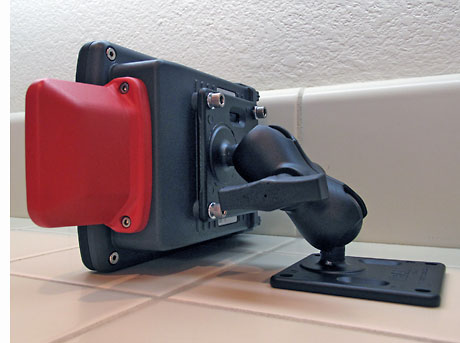 The Advantech-DLoG merger was intended to leverage the strategic competence of DLoG's strong vehicle mount design talents with Taiwan based engineering and worldwide presence, quick time to market and cost-efficiency. So far, things seem to work out well. The Advantech-DLoG merger was intended to leverage the strategic competence of DLoG's strong vehicle mount design talents with Taiwan based engineering and worldwide presence, quick time to market and cost-efficiency. So far, things seem to work out well.
We reviewed a series of DLoG devices similar to the current XMT 5/7 in 2008 when Datalogic and DLoG struck an OEM partnership deal where DLoG would supply its X-series terminals to Datalogic and came away impressed. That fanless platform for vehicle mount applications was originally designed to run Windows XP, XP Embedded or even Linux on low power Intel processors, but was then complemented with Windows CE-based versions using the same Marvell PXA application processors used in millions of Windows CE and Windows Mobile-based handheld and embedded devices.
The XMT 5/7 -- compact, super-tough vehicle mount
The Advantech DLoG XMT 5/7 with its 7-inch display is the most compact model in DLoG's lineup of virtually invulnerable vehicle mounts. It is suitable for forklifts and other applications where space is at a premium and the device will be subject to all sorts of abuse. It measures roughly six by nine inches (without the protruding WiFi card/antenna cover) and is a bit over three inches thick. Weight doesn't matter much in a vehicle or fixed-mounted system, but the XMT 5/7's remarkably low weight of 4.75 pounds still comes in handy. The device, made entirely of aluminum, feels unbelievably solid, as if it were milled from a solid block of the metal. There are screw holes on the top, bottom and back for a variety of mounting systems. The device itself is designed for use in either portrait or landscape mode. Below you can see what it looks like from the front and all four sides.
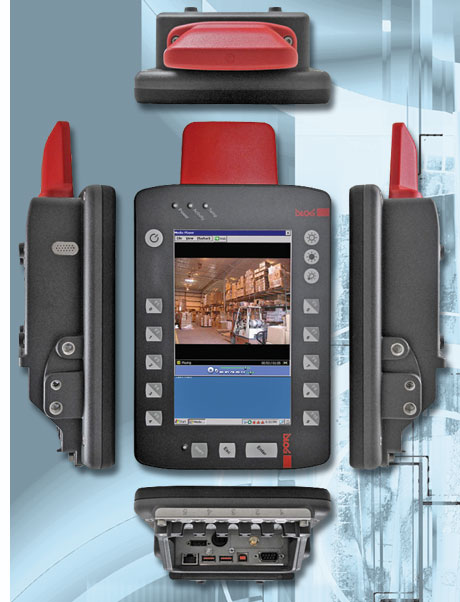 As the name implies sort of implies, the XMT 5/7 uses a display that measures seven inches diagonally. It is a color TFT with wide-format 800 x 480 pixel (WVGA) resolution, more than enough for most standard and custom applications in this class of device. The display has a very bright backlight and a resistive touch screen. DLoG offers a variety of compact external keyboards with both ABCD and QWERTY layouts. Input can also be via touch in custom applications, or via onscreen keyboard. The XMT 5/7 comes with the standard Windows CE pop-up keyboard and also with a special DLoG keyboard/input panel with function keys. As the name implies sort of implies, the XMT 5/7 uses a display that measures seven inches diagonally. It is a color TFT with wide-format 800 x 480 pixel (WVGA) resolution, more than enough for most standard and custom applications in this class of device. The display has a very bright backlight and a resistive touch screen. DLoG offers a variety of compact external keyboards with both ABCD and QWERTY layouts. Input can also be via touch in custom applications, or via onscreen keyboard. The XMT 5/7 comes with the standard Windows CE pop-up keyboard and also with a special DLoG keyboard/input panel with function keys.
As you can see on the pictures of the XMT 5/7, the device has a number of membrane-style pushbuttons arranged around the display. They include power, brightness up and down, backlight on/off, enter, escape, shift, as well as ten function keys that can be assigned via a utility, actions and applications. The utility also lets you access certain admin functions, set authorized applications, set error redirection pages, and so on. Each key actually has a double function; in unshifted mode, the ten function keys work as numeric input keys.
From a technical standpoint, the XMT 5/7 (and the XMT 5/10 version with a larger 10-inch display) vehicle mounts are Windows CE 6.0-based systems using the 806 MHz version of the Marvell XScale PXA320 processor. This is the successor to the ubiquitous PXA270 processor used in millions of Pocket PCs and other Windows CE devices, and also the most powerful and advanced version of the PXA line. There are 256MB of RAM and Flash ROM each. In terms of expansion cards, unlike the earlier X7 which had a PC Card Type II slot (as long as you didn't use the CF card slot that was also available), the XMT 5/7 comes with a CF Card slot for a radio module and an SD Card slot for additional storage (see picture below).  For connectivity, the device has two standard US 2.0 ports, an mini-USB client port, a RS232 DB9 serial port, an RJ45 LAN jack, and an external antenna port. Our review unit also had an additional USB port sitting next to the expansion cards, presumably for use with cards or expansion modules that may also need a USB port. On the XMT 5/7, all ports are on the right (or bottom if you use the device in portrait mode) side of the device, deeply recessed into the unit so that jacks and plugs do not get in the way. For wireless networking connectivity, there is 802.11b/g WiFi. For connectivity, the device has two standard US 2.0 ports, an mini-USB client port, a RS232 DB9 serial port, an RJ45 LAN jack, and an external antenna port. Our review unit also had an additional USB port sitting next to the expansion cards, presumably for use with cards or expansion modules that may also need a USB port. On the XMT 5/7, all ports are on the right (or bottom if you use the device in portrait mode) side of the device, deeply recessed into the unit so that jacks and plugs do not get in the way. For wireless networking connectivity, there is 802.11b/g WiFi.
As a vehicle mount system, the XMT 5/7 is designed to run on on 12/24 or 24/48 Volt DC. It can handle fairly significant voltage sags (up to 5 Volts), but there is no internal backup battery.
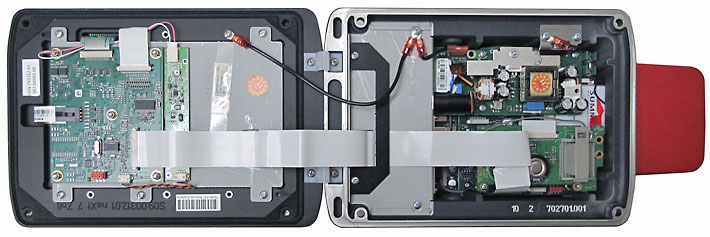
The walls of the housing of the device are bunker-like thick. We're talking a full 5mm machined aluminum. This is about as rock-solid as we've ever seen. The design, likewise, is as intelligent and logical as can be. When opened (see above), the two halves are held together with two plastic hinges. That way, when you undo the four thick Allen wrench screws and open the unit, the heavy halves won't fall and rip off wires and cables. 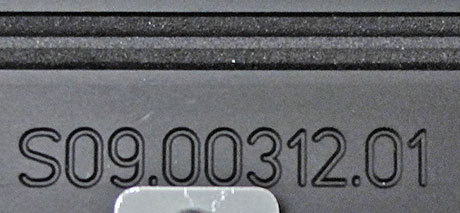 Whereas many rugged devices that come through our labs include a disconcertingly large number of potential weak points that all must be sealed perfectly in order to keep dust and water out, the DLoG is so clean and simple that this never seems a problem at all. The pressure seal between the main housing and the back plate is simple and reliable in design, easy to replace, and there simply seems no way that it'd ever leak. Even small things like serial numbers are handled with a clarity and precision hardly ever seen — they are milled right into the housing in large, easily readable numbers (see picture to the right). Whereas many rugged devices that come through our labs include a disconcertingly large number of potential weak points that all must be sealed perfectly in order to keep dust and water out, the DLoG is so clean and simple that this never seems a problem at all. The pressure seal between the main housing and the back plate is simple and reliable in design, easy to replace, and there simply seems no way that it'd ever leak. Even small things like serial numbers are handled with a clarity and precision hardly ever seen — they are milled right into the housing in large, easily readable numbers (see picture to the right).
The interior of the XMT 5/7 is surprisingly complex. For a CE device you might expect a simple small system board, but there's quite a bit inside the sturdy, compact housing of this machine. Each sub-system has its own board and all those boards are meticulously stacked and mounted, six in all. That includes a DC voltage regulator/converter, a Trimble GPS module/antenna, an I/O board with a CF Card interface occupied by a Summit Communications SDC-CF10G 802.11G Radio Module with antenna, etc. Almost needless to say, all of the boards are flawless and without any fixes or imperfections. Also impressive is the meticulous grounding of whatever needs to be grounded.
Ruggedness
The Advantech DLoG XMT 5/7 is an extremely solid and rugged machine. Its fanless housing is designed specifically to handle the shock and vibration encountered in rigid suspension vehicles.
The listed environmental testing results include both US and European standard testing. There is no drop spec as that usually doesn't pertain to fixed-mount units. Shock and vibration testing results are given as per the European EN 60721-3 standards.
The XMT 5/7 is heavily sealed and can handle a very wide -22 to 122 degree Fahrenheit operating temperature range. Essentially, that means that extended freezer applications are possible with this model.
With regard to sealing against solids and liquids, DLoG supports IP66 and IP67. What does that all mean? The first number refers to protection against solids. "6" means complete protection against dust. The second number means protection against liquids. "6" means protection even against strong jets of water from all directions (making pressure washing possible), "7" means protection means protection even against limited immersion (which is not likely to happen in a vehicle).
Mounting solutions: RAM Mounts
A wide variety of mounting solutions are available for the XMT 5/7, including sun visor mounts, mounts for the optional barcode reader, swiveling brackets, and the uniquely versatile RAM Mount solutions. RAM, the undisputed leader in mounting solutions, utilizes a patented ball and socket mounting system that allows you to mount practically anything anywhere.
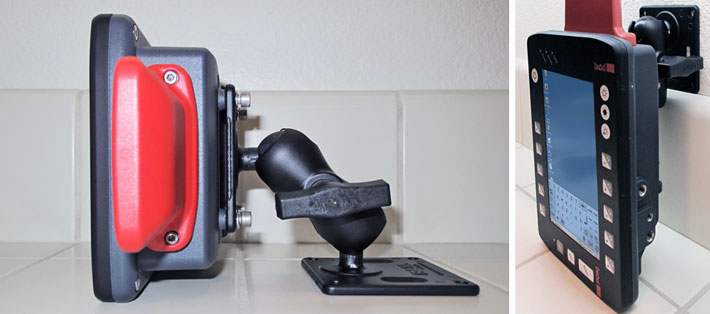
Another word about the sealing: do note that the unit's I/O block is not actually sealed against. Apparently it's difficult to seal industry standard ports such as RJ45 jacks, USB connectors and even serial ports, probably because they were never designed to be used in water. So even if the ports were sealed to the inside, the standard connectors themselves aren't, or at least not without rubber boots and such. DLoG's solution was to provide a large cover for the entire I/O compartment, one with a reliable pressure seal. It also provides rubber inserts for the five cabling cutouts in the aluminum housing. This way, users can select, from a supply of 16 rubber seals that fit into the cutouts, the right ones for their cabling and block unused conduits. A solid solution, at least for vehicle use where the cabling won't be plugged in and unplugged a lot.

A word about the operating systems: Windows vs. Windows CE
The XMT 5/7 uses Windows CE 6.0, so for those not familiar with the Windows CE system used in both versions of the XMT series, here's a brief overview: Since Windows CE is an embedded OS, it contains only a small subset of all the functions and functionality of a full OS. The idea is to include exactly what a user needs, as opposed to the everything-and-the-kitchen-sink approach of a full desktop OS like Vista. Microsoft makes certain application programs available for Windows CE, and depending on the version those may include limited versions of most of the familiar Office apps as well as image viewers and other more consumer-oriented applications.
It gets a bit confusing here because at some point Microsoft began making a distinction between consumer-oriented devices (Pocket PCs, etc.) and the more industrial handhelds. The Pocket PC/PDA side of things evolved into Windows Mobile (now called Embedded Handheld Compact), which has a somewhat friendlier interface found on many handhelds today. Windows CE, on the other hand, concentrated on being a tool for jobs. Companies such as Advantech DLoG often offer both Windows Mobile and Windows CE on a platform since customers may have different requirements.
Below are a few screen captures from the XMT 5/7. From left to right, 1) the bare desktop with icon links to often used apps and utilities, 2) the settings page with all the control panel apps, 3) the Internet Explorer browser that's quite functional with 800 x 480 resolution, and d) the Windows Media Player.
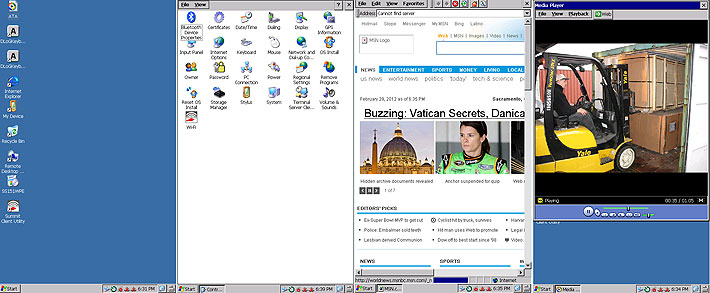
But why Windows CE 6.0 instead of an embedded version of "full" Windows, such as XP Embedded or even Windows Embedded Standard 7? Because Windows CE remains a very compact, very efficient and scalable operating system that was designed for a broad range of embedded systems and products and has plenty of programming support and a rich subset of Microsoft Win32 APIs.
Further, CE's multi-threaded, multi-tasking, fully preemptive OS environment was targeted from the start specifically toward hardware with limited resources. Windows CE supports a rich subset of Microsoft Win32 APIs and several additional programming interfaces. As a longtime supporter of Windows CE for industrial applications, Advantech DLoG has considerable experience with the platform. With the XMT 5/7 (and 5/10), there is no need to create onboard drivers or using the Platform Builder to create a CE image; DLoG supplies that, and also a series of enhancement and utilities to make the creation of customized software even simpler.
While Windows CE can include multimedia, PIM applications and communications tools, that is not the primary purpose here. Our XMT 5/7 test unit came with essentially just four of the common applications--Microsoft WordPad, email, Pocket Internet Explorer, and the Media Player. However, there were no fewer than 25 control panels and utilities to configure and fine-tune the device, and a typical customer device will probably run some custom-designed application software.
Advantec-DLoG: Some challenges
The merger of DLoG and Advantech also presents some challenges. Since Advantech had its own separate line of vehicle mount panels, there's now quite a variety of related products in the merged companies, all with similar, but not identical purpose, and a somewhat confusing nomenclature. On the DLoG side alone are the ITC 7, IPC 7, MPC 6, MTC 6, XMT 5/10 and XMT 5/7, so careful study of the Advantech-DLoG product catalog is advisable (it is here).
In essence, DLoG offers product lines running Windows CE and product lines running Windows XP, XP Embedded, and Windows Embedded Standard 7. The Windows CE products are based on Marvell PXA processors, whereas the Windows XP/XPE/WES7 models use Intel Celeron, Core Duo and Atom processors. Each model line may come in different screen sizes, those being 7, 10, 12, and 15 inches. Some models appear to be available in both a Windows CE and Windows XP/XP/WES7 version. For example, the 10 and 12-inch versions of the Windows XP/XPE based MPC 6 correspond to the Windows CE-based X10 and X12. The difference between the Windows XP/XPE based 15-inch ITC 7 and IPC 7 seems that the latter is tougher and more elaborate. The difference between the almost identically-bodied Windows CE-based X7/X10 and the also CE-based XMT 5/7 and 5/10 seems that the latter has more modern electronics and extra functionality. Those interested in the full details can download the respective spec sheets of all of the above panels from the DLoG download center page.
Summary: The Advantec DLoG XMT 5/7
Anyone operating fork lifts or any similar workhorse vehicles in warehousing, on docks — or anyplace where moving goods to and from places while keeping meticulous track of what is where ° knows that onboard computers with appropriate data capture and communications capabilities are the answers. 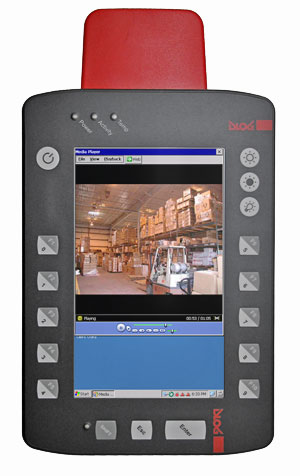 Suitable, customized and optimized software is key, of course, but so is hardware that suits the job and is as tough and durable as the vehicles it's mounted in. Suitable, customized and optimized software is key, of course, but so is hardware that suits the job and is as tough and durable as the vehicles it's mounted in.
The Advantech DLoG XMT 5/7 is such a device. It is remarkably compact, weighing under five pounds and fitting almost anywhere. It's small, but the 7-inch display is still large enough to be easily readable, and it's bright enough to be viewed and used outdoors. Its 800 x 480 pixel WVGA resolution is high enough for fairly complex applications. The Windows CE 6.0 operating system used is simple compared to full Windows 7, but its an industry standard gets the job done. And the 806MHz PXA320 processor is plenty powerful enough to drive any Windows CE application.
While the XMT is fanless and doesn't have any visible ports and openings once it is installed, it offers excellent connectivity both for current and legacy connections and peripherals. CAN Bus is available as an option. Wireless connectivity is excellent as well, both WiFi and WWAN, and there's optional GPS as well.
Once configured and installed, the DLoG XMT 5/7 is virtually unbreakable. Its extremely solid aluminum housing is built to last and it can be mounted in numerous ways, including sun visor mounts, mounts for optional barcode readers, swiveling brackets, and the versatile RAM Mount solutions. Sealing is such that the device can be pressure washed. Operation can be via touch or programmable hardware buttons.
For software development, there is the standard Windows CE SDK as well as numerous terminal emulations and clients, such as VT100, VT220, IBM 5250, TN 3270, Citrix ICA Client, and RDP Client.
– Conrad H. Blickenstorfer, March 2012
|
Advantech DLoG XMT 5/7 Specifications
|
| Added/changed |
Added 3/2012
|
| Type |
Rugged vehicle mount computer
|
| Processor |
806MHz Marvell XScale PXA320 |
| OS |
Windows CE 6.0 |
| RAM/ROM |
256MB SDRAM, 256MB Flash |
| Display |
7.0-inch, 800 x 480 pixel, 500 nits backlight |
| Digitizer/Pens |
resistive touchscreen/1 |
| Keyboard |
Onscreen or optional external keyboards with ABCD or QWERTY layouts |
| Slots |
1 CF Card, externally accessible, 1 SDHC (up to 4GB extended memory) |
| Housing |
Aluminum |
| Temperature |
-22° to 122° Fahrenheit (-30° to +50° C) |
| Humidity |
10-90% at 104F, non-condensing |
| Shock/Vibration |
Class 5M3 according DIN EN 60721-3-5 and MIL-STD 810F (US Highway Truck) |
| Enclosure Class |
IP67 and IP66 |
| Size (inches) |
R Series 7: 11.4 x 6.2 x 2.8 inches
|
| Weight |
4.75 pounds as tested (incl. WiFi antenna cover)
|
| Power |
12/24 or 24/48 VDC, galvanically isolated, voltage sags up to 5 VDC can be handled for up to 20 sec.
|
| Communication |
Summit Data Communication SDC-CF10G 802.11g Compact Flash Radio Module; available WWAN - EDGE 2.5G / GSM Quadband |
| Interface |
1 RS232 (optionally 2 x RS-232 or 1 x RS-232 and 1 x RS-422/485), 2 USB 2.0, 1 USB 2.0 client, 1 Service USB 2.0, CAN Bus |
Price |
Inquire |
| Contact |
Advantech DLoG XMT 5/7 page |
|
|



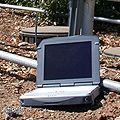


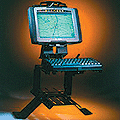





 The Advantech-DLoG merger was intended to leverage the strategic competence of DLoG's strong vehicle mount design talents with Taiwan based engineering and worldwide presence, quick time to market and cost-efficiency. So far, things seem to work out well.
The Advantech-DLoG merger was intended to leverage the strategic competence of DLoG's strong vehicle mount design talents with Taiwan based engineering and worldwide presence, quick time to market and cost-efficiency. So far, things seem to work out well.
 As the name implies sort of implies, the XMT 5/7 uses a display that measures seven inches diagonally. It is a color TFT with wide-format 800 x 480 pixel (WVGA) resolution, more than enough for most standard and custom applications in this class of device. The display has a very bright backlight and a resistive touch screen. DLoG offers a variety of compact external keyboards with both ABCD and QWERTY layouts. Input can also be via touch in custom applications, or via onscreen keyboard. The XMT 5/7 comes with the standard Windows CE pop-up keyboard and also with a special DLoG keyboard/input panel with function keys.
As the name implies sort of implies, the XMT 5/7 uses a display that measures seven inches diagonally. It is a color TFT with wide-format 800 x 480 pixel (WVGA) resolution, more than enough for most standard and custom applications in this class of device. The display has a very bright backlight and a resistive touch screen. DLoG offers a variety of compact external keyboards with both ABCD and QWERTY layouts. Input can also be via touch in custom applications, or via onscreen keyboard. The XMT 5/7 comes with the standard Windows CE pop-up keyboard and also with a special DLoG keyboard/input panel with function keys.
 For connectivity, the device has two standard US 2.0 ports, an mini-USB client port, a RS232 DB9 serial port, an RJ45 LAN jack, and an external antenna port. Our review unit also had an additional USB port sitting next to the expansion cards, presumably for use with cards or expansion modules that may also need a USB port. On the XMT 5/7, all ports are on the right (or bottom if you use the device in portrait mode) side of the device, deeply recessed into the unit so that jacks and plugs do not get in the way. For wireless networking connectivity, there is 802.11b/g WiFi.
For connectivity, the device has two standard US 2.0 ports, an mini-USB client port, a RS232 DB9 serial port, an RJ45 LAN jack, and an external antenna port. Our review unit also had an additional USB port sitting next to the expansion cards, presumably for use with cards or expansion modules that may also need a USB port. On the XMT 5/7, all ports are on the right (or bottom if you use the device in portrait mode) side of the device, deeply recessed into the unit so that jacks and plugs do not get in the way. For wireless networking connectivity, there is 802.11b/g WiFi.

 Whereas many rugged devices that come through our labs include a disconcertingly large number of potential weak points that all must be sealed perfectly in order to keep dust and water out, the DLoG is so clean and simple that this never seems a problem at all. The pressure seal between the main housing and the back plate is simple and reliable in design, easy to replace, and there simply seems no way that it'd ever leak. Even small things like serial numbers are handled with a clarity and precision hardly ever seen — they are milled right into the housing in large, easily readable numbers (see picture to the right).
Whereas many rugged devices that come through our labs include a disconcertingly large number of potential weak points that all must be sealed perfectly in order to keep dust and water out, the DLoG is so clean and simple that this never seems a problem at all. The pressure seal between the main housing and the back plate is simple and reliable in design, easy to replace, and there simply seems no way that it'd ever leak. Even small things like serial numbers are handled with a clarity and precision hardly ever seen — they are milled right into the housing in large, easily readable numbers (see picture to the right).



 Suitable, customized and optimized software is key, of course, but so is hardware that suits the job and is as tough and durable as the vehicles it's mounted in.
Suitable, customized and optimized software is key, of course, but so is hardware that suits the job and is as tough and durable as the vehicles it's mounted in.